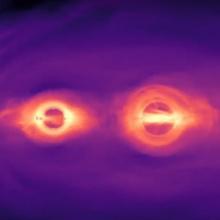
Abstract
We present the first fully relativistic prediction of the electromagnetic emission from the surrounding gas of a supermassive binary black hole system approaching merger. Using a ray-tracing code to post-process data from a general relativistic 3-d MHD simulation, we generate images and spectra, and analyze the viewing angle dependence of the light emitted. When the accretion rate is relatively high, the circumbinary disk, accretion streams, and mini-disks combine to emit light in the UV/EUV bands. We posit a thermal Compton hard X-ray spectrum for coronal emission; at high accretion rates, it is almost entirely produced in the mini-disks, but at lower accretion rates it is the primary radiation mechanism in the mini-disks and accretion streams as well. Due to relativistic beaming and gravitational lensing, the angular distribution of the power radiated is strongly anisotropic, especially near the equatorial plane.